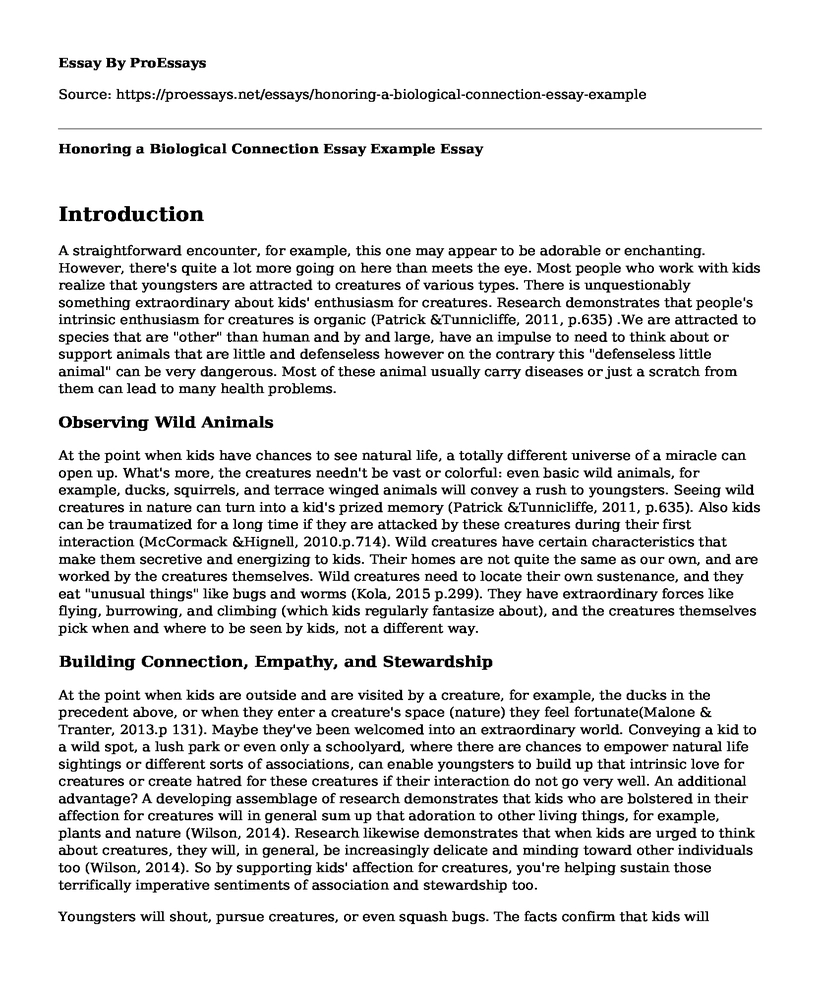Introduction
A straightforward encounter, for example, this one may appear to be adorable or enchanting. However, there's quite a lot more going on here than meets the eye. Most people who work with kids realize that youngsters are attracted to creatures of various types. There is unquestionably something extraordinary about kids' enthusiasm for creatures. Research demonstrates that people's intrinsic enthusiasm for creatures is organic (Patrick &Tunnicliffe, 2011, p.635) .We are attracted to species that are "other" than human and by and large, have an impulse to need to think about or support animals that are little and defenseless however on the contrary this "defenseless little animal" can be very dangerous. Most of these animal usually carry diseases or just a scratch from them can lead to many health problems.
Observing Wild Animals
At the point when kids have chances to see natural life, a totally different universe of a miracle can open up. What's more, the creatures needn't be vast or colorful: even basic wild animals, for example, ducks, squirrels, and terrace winged animals will convey a rush to youngsters. Seeing wild creatures in nature can turn into a kid's prized memory (Patrick &Tunnicliffe, 2011, p.635). Also kids can be traumatized for a long time if they are attacked by these creatures during their first interaction (McCormack &Hignell, 2010.p.714). Wild creatures have certain characteristics that make them secretive and energizing to kids. Their homes are not quite the same as our own, and are worked by the creatures themselves. Wild creatures need to locate their own sustenance, and they eat "unusual things" like bugs and worms (Kola, 2015 p.299). They have extraordinary forces like flying, burrowing, and climbing (which kids regularly fantasize about), and the creatures themselves pick when and where to be seen by kids, not a different way.
Building Connection, Empathy, and Stewardship
At the point when kids are outside and are visited by a creature, for example, the ducks in the precedent above, or when they enter a creature's space (nature) they feel fortunate(Malone & Tranter, 2013.p 131). Maybe they've been welcomed into an extraordinary world. Conveying a kid to a wild spot, a lush park or even only a schoolyard, where there are chances to empower natural life sightings or different sorts of associations, can enable youngsters to build up that intrinsic love for creatures or create hatred for these creatures if their interaction do not go very well. An additional advantage? A developing assemblage of research demonstrates that kids who are bolstered in their affection for creatures will in general sum up that adoration to other living things, for example, plants and nature (Wilson, 2014). Research likewise demonstrates that when kids are urged to think about creatures, they will, in general, be increasingly delicate and minding toward other individuals too (Wilson, 2014). So by supporting kids' affection for creatures, you're helping sustain those terrifically imperative sentiments of association and stewardship too.
Youngsters will shout, pursue creatures, or even squash bugs. The facts confirm that kids will probably do these things! It's typical, some portion of how kids are figuring out how to play with their very own capacity and investigate defenselessness. In all actuality, youngsters are doing these things to learn but also it may be worrying that the youngsters may overdo it and tend to love it. They need to know "what occurs in the event that I... ... "And the ideal approach to discover is to attempt it. When they see the impacts of their conduct on creatures, youngsters find out about their own abilities and the effects that they have (Malone & Tranter, 2013.p 124). Supporting youngsters in their developing mindfulness and enthusiasm for creatures can prompt further sentiments of compassion in youthful kids, increasingly positive study hall connections, and social-passionate advancement but the support should be to a certain limit as kids also need to be advised on the do's and don'ts.
References
Wilson, R., 2014. Nature and young children: Encouraging creative play and learning in natural environments. Routledge.
Malone, K. and Tranter, P., 2013. "Children's Environmental Learning and the Use, Design and Management of Schoolgrounds. Children youth and environments, 13(2), pp.87-137.
McCormack, G.R., Rock, M., Toohey, A.M., and Hignell, D., 2010. Characteristics of urban parks associated with park use and physical activity: A review of qualitative research. Health & place, 16(4), pp.712-726.
KolaOlusanya*, A., 2015. Freechoice environmental education: understanding where children learn outside of school. Environmental education research, 11(3), pp.297-307.
Patrick, P. and Tunnicliffe, S.D., 2011. What plants and animals do early childhood and primary students' name? Where do they see them?. Journal of Science Education and Technology, 20(5), pp.630-642.
Cite this page
Honoring a Biological Connection Essay Example. (2022, Dec 06). Retrieved from https://proessays.net/essays/honoring-a-biological-connection-essay-example
If you are the original author of this essay and no longer wish to have it published on the ProEssays website, please click below to request its removal:
- Postpartum Depression Caused by Domestic Violence Paper Example
- Eating Disorder Case Study Analysis
- Essay Example on Infants of Depressed Moms: Effects of Maternal Depression and Antidepressants
- Essay Sample on Digestive System: Components, Functions, & GI Alterations
- Essay Sample on Mountain Formation: Orogeny, Volcanism & Tectonics
- Maternal Depression: Low Self-Esteem, Fatigue & More - Essay Sample
- Essay Example on Live Life With No Regrets: Make Conscious Choices







